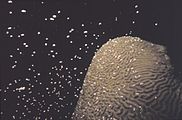Coral
| Coral | |
|---|---|

| |
| Pillar coral, Dendrogyra cylindricus | |
| Scientific classification | |
| Kingdom: | |
| Phylum: | |
| Class: | Ehrenberg, 1831
|
| Extant Subclasses and Orders | |
|
Alcyonaria | |
Corals are marine animals in class Anthozoa of phylum Cnidaria typically living in compact colonies of many identical individual "polyps". The group includes the important reef builders that inhabit tropical oceans and secrete calcium carbonate to form a hard skeleton.
A coral "head" is a colony of myriad genetically identical polyps. Each polyp is a spineless animal typically only a few millimeters in diameter and a few centimeters in length. A set of tentacles surround a central mouth opening. An exoskeleton is excreted near the base. Over many generations, the colony thus creates a large skeleton that is characteristic of the species. Individual heads grow by asexual reproduction of polyps. Corals also breed sexually by spawning: polyps of the same species release gametes simultaneously over a period of one to several nights around a full moon.
Although corals can catch small fish and plankton, using stinging cells on their tentacles, most corals obtain the majority of their energy and nutrients from photosynthetic unicellular algae called zooxanthellae that live within the coral's tissue. Such corals require sunlight and grow in clear, shallow water, typically at depths shallower than 60 metres (200 ft). Corals can be major contributors to the physical structure of the coral reefs that develop in tropical and subtropical waters, such as the enormous Great Barrier Reef off the coast of Queensland, Australia. Other corals do not have associated algae and can live in much deeper water, with the cold-water genus Lophelia surviving as deep as 3,000 metres (9,800 ft).[3] Examples live on the Darwin Mounds located north-west of Cape Wrath, Scotland. Corals have also been found off the coast of the U.S. in Washington State and the Aleutian Islands in Alaska.
Taxonomy
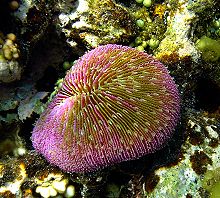
Corals divide into two subclasses, depending on the number of tentacles or lines of symmetry, and a series of orders corresponding to their exoskeleton: nematocyst type and mitochondrial genetic analysis.[1][2][4] Common coral typing crosses suborder/class boundaries.
Hermatypic corals
Hermatypic corals in the subclass Scleractinia are stony corals that build reefs. They mostly obtain at least part of their energy requirements from zooxanthellae, symbiotic photosynthetic microalgae. They secrete calcium carbonate to form a hard skeleton. Those having six or fewer lines of symmetry in their body structure are called hexacorallia or Zoantharia. This group includes reef-building corals (scleractinians), sea anemones and zoanthids. Hermatypic genera include Scleractinia, Millepora, Tubipora and Heliopora.[5]
In the Caribbean alone, at least 50 species of uniquely structured hard coral exist. Well-known types include:
- Brain corals grow to 1.8 meters (5.9 ft) in width.
- Acropora and staghorn corals grow fast and large, and are important reef-builders. Staghorn coral displays large, antler-like branches, and grows in areas with strong surf.
- Pillar coral forms pillars which can grow to 3 meters (9.8 ft) in height.
- Leptopsommia, or rock coral, appears almost everywhere in the Caribbean.[6]
Ahermatypic corals
Ahermatypic corals have no zooxanthellae. They sport eight tentacles and are also called octocorallia. They include corals in subclass Alcyonacesdasda, as well as some species in order Anthipatharia (black coral, Cirripathes, Antipathes).[5] Ahermatypic corals, such as sea whips, sea feathers, and sea pens,[6] are also known as soft corals. Unlike stony corals, they are flexible, undulating in the current, and often are perforated, with a lacy appearance. Their skeletons are proteinaceous, rather than calcareous. Soft corals are somewhat less plentiful (in the Caribbean, twenty species appear) than stony corals.
Perforate corals
Corals can be perforate or imperforate. Perforate corals have porous skeletons, which allows their polyps to connect with each other through the skeleton. Imperforate corals have hard solid skeletons.[7][8]
Anatomy

The Muslim polymath Al-Biruni (d. 1048) classified sponges and corals as animals arguing that they respond to touch.[9] Nevertheless, people believed coral to be a plant until the 18th century, when William Herschel used a microscope to establish that coral had the characteristic thin cell membranes of an animal.[10]
Colonial form
The polyps interconnect by a complex and well-developed system of gastrovascular canals, allowing significant sharing of nutrients and symbiotes. In soft corals, these range in size from 50–500 micrometres (0.0020–0.0197 in) in diameter, and allow transport of both metabolites and cellular components.[11]

Polyp
While the coral head is the familiar visual form of a single organism, it is actually a group of many individual, yet genetically identical, multicellular organisms known as polyps. Polyps are usually a few millimeters in diameter, and are formed by a layer of outer epithelium and inner jellylike tissue known as the mesoglea. They are radially symmetrical, with tentacles surrounding a central mouth, the only opening to the stomach or coelenteron, through which food is ingested and waste expelled.
Exoskeleton
The stomach closes at the base of the polyp, where the epithelium produces an exoskeleton called the basal plate or calicle (L. small cup). The calicle is formed by a thickened calcareous ring (annular thickening) with six supporting radial ridges (as shown below). These structures grow vertically and project into the base of the polyp. When a polyp is physically stressed, its tentacles contract into the calyx so that virtually no part is exposed above the skeletal platform. This protects the organism from predators and the elements.[12][13]
The polyp grows by extension of vertical calices which occasionally septate to form a new, higher, basal plate. Over many generations, this extension forms the large calcareous structures of corals and ultimately coral reefs.
Formation of the calcareous exoskeleton involves deposition of the mineral aragonite by the polyps from calcium and carbonate ions they acquire from seawater. The rate of deposition, while varying greatly across species and environmental conditions, can reach 10 g/m² of polyp/day (0.3 ounce/sq yd/day). This is light dependent, with night-time production 90% lower than that during the middle of the day.[14]

Tentacles
Nematocysts at the tips of the calices are stinging cells that carry venom which they rapidly release in response to contact with another organism. The tentacles also bear a contractile band of epithelium called the pharynx. Jellyfish and sea anemones also carry nematocysts.
Ecology
Feeding
Polyps feed on a variety of small organisms, from microscopic demersal plankton to small fish. The polyp's tentacles immobilize or kill prey using their nematocysts (also known as 'cnidocysts'). The tentacles then contract to bring the prey into the stomach. Once the prey is digested, the stomach reopens, allowing the elimination of waste products and the beginning of the next hunting cycle. They can scavenge drifting organic molecules and dissolved organic molecules.[15]: 24
Zooxanthellae symbiote
Many corals, as well as other cnidarian groups such as Aiptasia (a sea anemone) form a symbiotic relationship with a class of algae, zooxanthellae, of the genus Symbiodinium, a dinoflagellate.[15]: 24 Aiptasia, in a familiar pest among coral reef aquarium hobbyists, serves as a valuable model organism in the study of cnidarian-algal symbiosis. Typically, each polyp harbors one species of algae. Via photosynthesis, these provide energy for the coral, and aid in calcification.[16] As much as 30% of the tissue of a polyp may be plant material.[15]: 23
The algae benefit from a safe place to live and consume the polyp's carbon dioxide and nitrogenous waste. Due to the strain the algae can put on the polyp, stress on the coral often drives them to eject the algae. Mass ejections are known as coral bleaching, because the algae contribute to coral's brown coloration; other colors, however, are due to host coral pigments, such as green fluorescent proteins (GFPs). Ejection increases the polyp's chance of surviving short-term stress—they can regain algae, possibly of a different species at a later time. If the stressful conditions persist, the polyp eventually dies.[17]
Reproduction
Corals can be both gonochoristic (unisexual) and hermaphroditic, each of which can reproduce sexually and asexually. Reproduction also allows coral to settle in new areas.
Sexual
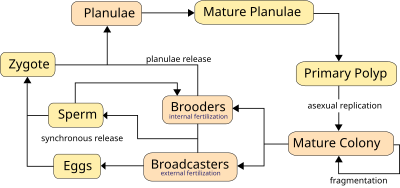
Corals predominantly reproduce sexually. About 25% of hermatypic corals (stony corals) form single sex (gonochoristic) colonies, while the rest are hermaphroditic.[18]
Broadcasters
About 75% of all hermatypic corals "broadcast spawn" by releasing gametes—eggs and sperm—into the water to spread offspring. The gametes fuse during fertilization to form a microscopic larva called a planula, typically pink and elliptical in shape. A typical coral colony forms several thousand larvae per year to overcome the odds against formation of a new colony.[19]

Synchronous spawning is very typical on the coral reef, and often, even when multiple species are present, all corals spawn on the same night. This synchrony is essential so male and female gametes can meet. Corals rely on environmental cues, varying from species to species, to determine the proper time to release gametes into the water. The cues involve temperature change, lunar cycle, day length, and possibly chemical signalling.[18] Synchronous spawning may form hybrids and is perhaps involved in coral speciation.[20] The immediate cue is most often sunset, which cues the release.[18] The spawning event can be visually dramatic, clouding the usually clear water with gametes.
Brooders
Brooding species are most often ahermatypic (not reef-building) in areas of high current or wave action. Brooders release only sperm, which is negatively buoyant, sinking on to the waiting egg carriers who harbor unfertilized eggs for weeks. Synchronous spawning events sometimes occurs even with these species.[18] After fertilization, the corals release planula that are ready to settle.[16]
Planulae
Planulae exhibit positive phototaxis, swimming towards light to reach surface waters, where they drift and grow before descending to seek a hard surface to which they can attach and begin a new colony. They also exhibit positive sonotaxis, moving towards sounds that emanate from the reef and away from open water.[21] High failure rates afflict many stages of this process, and even though millions of gametes are released by each colony, few new colonies form. The time from spawning to settling is usually two to three days, but can be up to two months.[22] The larva grows into a polyp and eventually becomes a coral head by asexual budding and growth.
Asexual


Within a coral head, the genetically identical polyps reproduce asexually, either via gemmation (budding) or by longitudinal or transversal division, both shown in the photo of Orbicella annularis.
Budding involves splitting a smaller polyp from an adult.[19] As the new polyp grows, it forms its body parts. The distance between the new and adult polyps grows, and with it, the coenosarc (the common body of the colony; see coral anatomy). Budding can be:
- Intratentacular—from its oral discs, producing same-sized polyps within the ring of tentacles
- Extratentacular—from its base, producing a smaller polyp
Division forms two polyps each as large as the original. Longitudinal division begins when a polyp broadens and then divides its coelenteron, analogous to splitting a log along its length. The mouth also divides and new tentacles form. The two "new" polyps then generate their missing body parts and exoskeleton. Transversal division occurs when polyps and the exoskeleton divide transversally into two parts. This means one has the basal disc (bottom) and the other has the oral disc (top), similar to cutting the end off a log. The new polyps must separately generate the missing pieces.
Asexual reproduction has several benefits for these sessile colonial organisms:[23]
- Cloning allows high reproduction rates, supporting rapid habitat exploitation.
- Modular growth allows biomass to increase without a corresponding decrease in surface-to-volume ratio.
- Modular growth delays senescence, by allowing the clone-type to survive the loss of one or more modules.
- New modules can replace dead modules, reducing clone-type mortality and preserving the colony's territory.
- Spreading the clone type to distant locations reduces clone-type mortality from localized threats.
Colony division
Whole colonies can reproduce asexually, forming two colonies with the same genotype.[citation needed]
- Fission occurs in some corals, especially among the family Fungiidae, where the colony splits into two or more colonies during early developmental stages.
- Bailout occurs when a single polyp abandons the colony and settles on a different substrate to create a new colony.
- Fragmentation involves individuals broken from the colony during storms or other disruptions. The separated individuals can start new colonies.
Reefs

The hermatypic, stony corals are often found in coral reefs, large calcium carbonate structures generally found in shallow, tropical water. Reefs are built up from coral skeletons, and are held together by layers of calcium carbonate produced by coralline algae. Reefs are extremely diverse marine ecosystems hosting over 4,000 species of fish, massive numbers of cnidaria, mollusks, crustacea, and many other animals.[24]
Evolutionary history
This section needs additional citations for verification. (November 2011) |

| Stereo image | |||
|---|---|---|---|
| |||
| |||
| |||
| |||
| Horn coral fossil. | |||
Although corals first appeared in the Cambrian period,[25] some 542 million years ago, fossils are extremely rare until the Ordovician period, 100 million years later, when rugose and tabulate corals became widespread.
Tabulate corals occur in limestones and calcareous shales of the Ordovician and Silurian periods, and often form low cushions or branching masses alongside rugose corals. Their numbers began to decline during the middle of the Silurian period, and they became extinct at the end of the Permian period, 250 million years ago. The skeletons of tabulate corals are composed of a form of calcium carbonate known as calcite.
Rugose corals became dominant by the middle of the Silurian period, and became extinct early in the Triassic period. The rugose corals existed in solitary and colonial forms, and were also composed of calcite.
The scleractinian corals filled the niche vacated by the extinct rugose and tabulate species. Their fossils may be found in small numbers in rocks from the Triassic period, and became common in the Jurassic and later periods. Scleractinian skeletons are composed of a form of calcium carbonate known as aragonite.[26] Although they are geologically younger than the tabulate and rugose corals, their aragonitic skeleton is less readily preserved, and their fossil record is less complete.
 | |
|
Timeline of the major coral fossil record and developments from 650 m.y.a. to present.[27][28] |
|
At certain times in the geological past, corals were very abundant. Like modern corals, these ancestors built reefs, some of which ended as great structures in sedimentary rocks.
Fossils of fellow reef-dwellers algae, sponges, and the remains of many echinoids, brachiopods, bivalves, gastropods, and trilobites appear along with coral fossils. This makes some corals useful index fossils that enabled geologists to date the rocks in which they are found. Coral fossils are not restricted to reef remnants, and many solitary fossils may be found elsewhere, such as Cyclocyathus, which occurs in England's Gault clay formation.
A Petoskey stone is a rock and a fossil, often pebble-shaped, that is composed of a fossilized coral, Hexagonaria percarinata. They are found predominantly in Michigan's Upper Peninsula, and the northwestern portion of Michigan's Lower Peninsula.
Status
Threats
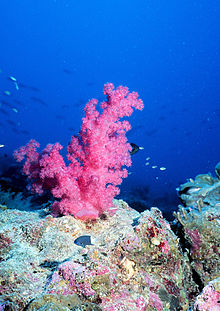
Coral reefs are under stress around the world.[29] In particular, coral mining, agricultural and urban runoff, pollution (organic and inorganic), overfishing, blast fishing, disease, and the digging of canals and access into islands and bays are localized threats to coral ecosystems. Broader threats are sea temperature rise, sea level rise and pH changes from ocean acidification, all associated with greenhouse gas emissions.[30] In 1998, 16% of the world's reefs died as a result of increased water temperature.[31]
General estimates show approximately 10% of the world's coral reefs are dead.[32][33][34] About 60% of the world's reefs are at risk due to human-related activities. The threat to reef health is particularly strong in Southeast Asia, where 80% of reefs are endangered.[citation needed] Over 50% of the world's coral reefs may be destroyed by 2030; as a result, most nations protect them through environmental laws.[35]
In the Caribbean and tropical Pacific, direct contact between ~40 to 70% of common seaweeds and coral causes bleaching and death to the coral via transfer of lipid–soluble metabolites.[36] Seaweed and algae proliferate given adequate nutrients and limited grazing by herbivores such as parrotfish.
Water temperature changes of more than 1-2 degrees Celsius (1.8-3.6 degrees Fahrenheit) or salinity changes can kill coral. Under such environmental stresses, corals expel their zooxanthellae; without them coral tissues reveal the white of their skeletons, an event known as coral bleaching.[37]
Submarine springs found along the coast of Mexico's Yucatán Peninsula produce water with a naturally low pH (a measure of acidity) providing conditions similar to those expected to become widespread as the oceans absorb carbon dioxide[citation needed]. Surveys discovered multiple species of live coral that appeared to tolerate the acidity. The colonies were small and patchily distributed, and had not formed structurally complex reefs such as those that compose the nearby Mesoamerican Barrier Reef System.[38]
Protection

Marine Protected Areas (MPAs), Biosphere reserves, marine parks, national monuments world heritage status, fishery management and habitat protection can protect reefs from anthropogenic damage.[39]
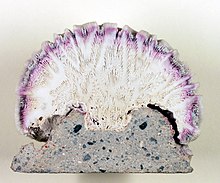
Many governments now prohibit removal of coral from reefs, and inform coastal residents about reef protection and ecology. While local action such as habitat restoration and herbivore protection can reduce local damage, the longer-term threats of acidification, temperature change and sea-level rise remain a challenge.[30]
To eliminate destruction of corals in their indigenous regions, projects have been started to grow corals in non-tropical countries.[40][41]
Relation to humans
Local economies near major coral reefs benefit from an abundance of fish and other marine creatures as a food source. Reefs also provide recreational scuba diving and snorkeling tourism. These activities can damage coral.
In medicine, chemical compounds from corals are used for cancer, AIDS, pain, and other uses. Coral skeletons, e.g., Isididae are also used for bone grafting in humans.[42]
Live coral is highly sought after for aquaria. Soft corals are easier to maintain in captivity than hard corals.[43]
Jewelry
Coral's many colors give it appeal for necklaces and other jewelry. Intensely red coral is prized as a gemstone. Sometimes called fire coral, it is not the same as fire coral. Red coral is very rare because of overharvesting.[citation needed]
Construction
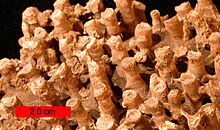
Coral reefs on land provide lime for use as building blocks ("coral rag"). Coral rag is an important local building material in places such as the East African coast.[citation needed]
Climate research
The annual growth bands in deep sea bamboo corals (Isididae) and others may be among the ocean's first organisms to display the effects of ocean acidification. They produce growth rings similar to those of trees, and can provide a view of changes in the condition in the deep sea over time.[44] They allow geologists to construct year-by-year chronologies, a form of incremental dating, which underlie high-resolution records of past climatic and environmental changes using geochemical techniques.[45]
Certain species form communities called microatolls, which are colonies whose top is dead and mostly above the water line, but whose perimeter is mostly submerged and alive. Average tide level limits their height. By analyzing the various growth morphologies, microatolls offer a low resolution record of sea level change. Fossilized microatolls can also be dated using radioactive carbon dating. Such methods can help to reconstruct Holocene sea levels.[46]
Aquaculture
Coral aquaculture, also known as coral farming or coral gardening, is the cultivation of corals for commercial purposes or coral reef restoration. Aquaculture is showing promise as a potentially effective tool for restoring coral reefs, which have been declining around the world.[47][48][49] The process bypasses the early growth stages of corals when they are most at risk of dying. Coral seeds are grown in nurseries then replanted on the reef.[50] Coral is farmed by coral farmers who live locally to the reefs and farm for reef conservation or for income. It is also farmed by scientists for research, by businesses for the supply of the live and ornamental coral trade and by private aquarium hobbyists.
See also
- Bamboo coral
- Coral dermatitis
- Coral Triangle
- Organ pipe coral
- Sea Turtle Association of Japan, Kuroshima Research Station
Gallery
Further images: commons:Category:Coral reefs and commons:Category:Coral
-
Fungia sp. skeleton
-
Polyps of Eusmilia fastigiata
-
Staghorn coral, Acropora
-
Orange cup coral, Balanophyllia elegans
-
Brain coral spawning
-
Brain coral releasing eggs
-
Glass bottom boats and a Semi submarine which are used for coral viewing at Green Island (Queensland), Great Barrier Reef, Australia
References
- ^ a b
Daly, M., Fautin, D.G., and Cappola, V.A. (2003). "Systematics of the Hexacorallia (Cnidaria: Anthozoa)". Zoological Journal of the Linnean Society. 139 (3): 419–437. doi:10.1046/j.1096-3642.2003.00084.x.
{{cite journal}}: Unknown parameter|month=ignored (help)CS1 maint: multiple names: authors list (link) - ^ a b
McFadden, C.S., France, S.C., Sanchez, J.A., and Alderslade, P. (2006). "A molecular phylogenetic analysis of the Octocorallia (Cnidaria: Anthozoa) based on mitochondrial protein-coding sequences". Molecular Phylogenentics and Evolution. 41 (3): 413–527. doi:10.1016/j.ympev.2006.06.010. PMID 16876445.
{{cite journal}}: Unknown parameter|month=ignored (help)CS1 maint: multiple names: authors list (link) - ^ Squires, D.F. (1959). "Deep sea corals collected by the Lamont Geological Observatory. 1. Atlantic corals". American Museum Novitates. 1965: 1–42.
- ^
France, S. C., P. E. Rosel, J. E. Agenbroad, L. S. Mullineaux, and T. D. Kocher (1996). "DNA sequence variation of mitochondrial large-subunit rRNA provides support for a two subclass organization of the Anthozoa (Cnidaria)". Molecular Marine Biology and Biotechnology. 5 (1): 15–28. PMID 8869515.
{{cite journal}}: Unknown parameter|month=ignored (help)CS1 maint: multiple names: authors list (link) - ^ a b The Greenpeace Book of Coral Reefs
- ^ a b National Geographic Traveller:The Caribbean
- ^ Triefeldt, Laurie (2007) Plants & Animals Page 65. Quill Driver Books. ISBN 978-1-884956-72-0
- ^ Chisolm, Hugh (1911). The Encyclopædia britannica: a dictionary of arts, sciences, literature and general information 11th edition. Encyclopedia Britannica. p. 104.
- ^ Egerton, Frank N. (2012). Roots of Ecology: Antiquity to Haeckel. University of California Press. p. 24. ISBN 0520953630.
- ^ The Light of Reason 8 August 2006 02:00 BBC Four
- ^
D. Gateno, A. Israel, Y. Barki and B. Rinkevich (1998). "Gastrovascular Circulation in an Octocoral: Evidence of Significant Transport of Coral and Symbiont Cells". The Biological Bulletin. 194 (2). Marine Biological Laboratory: 178–186. doi:10.2307/1543048. JSTOR 1543048.
{{cite journal}}: CS1 maint: multiple names: authors list (link) - ^ Barnes, R.D.k (1987). Invertebrate Zoology (5th ed.). Orlando, FL, USA: Harcourt Brace Jovanovich, Inc. pp. 149–163.
- ^ Sumich, J. L. (1996). An Introduction to the Biology of Marine Life (6th ed.). Dubuque, IA, USA: Wm. C. Brown. pp. 255–269.
- ^
"Anatomy of Coral". Marine Reef.
{{cite web}}: Missing or empty|url=(help) - ^ a b c Murphy, Richard C. (2002). Coral Reefs: Cities Under The Seas. The Darwin Press, Inc. ISBN 0-87850-138-X.
- ^ a b
Madl, P. and Yip, M. (2000). "Field Excursion to Milne Bay Province – Papua New Guinea". Retrieved 2006-03-31.
{{cite web}}: CS1 maint: multiple names: authors list (link) - ^ W. W. Toller, R. Rowan and N. Knowlton (2001). "Repopulation of Zooxanthellae in the Caribbean Corals Montastraea annularis and M. faveolata following Experimental and Disease-Associated Bleaching". The Biological Bulletin. 201 (3). Marine Biological Laboratory: 360–373. doi:10.2307/1543614. JSTOR 1543614. PMID 11751248.
- ^ a b c d Veron, J.E.N. (2000). Corals of the World. Vol 3 (3rd ed.). Australia: Australian Institute of Marine Sciences and CRR Qld Pty Ltd. ISBN 0-642-32236-8.
- ^ a b Barnes, R. and; Hughes, R. (1999). An Introduction to Marine Ecology (3rd ed.). Malden, MA: Blackwell Science, Inc. pp. 117–141. ISBN 0-86542-834-4.
- ^
Hatta, M., Fukami, H., Wang, W., Omori, M., Shimoike, K., Hayashibara, T., Ina, Y., Sugiyama, T. (1999). "Reproductive and genetic evidence for a reticulate evolutionary theory of mass spawning corals" (PDF). Molecular Biology and Evolution. 16 (11): 1607–1613. PMID 10555292.
{{cite journal}}: CS1 maint: multiple names: authors list (link) - ^ {{cite web url=http://www.sciencedaily.com/releases/2010/05/100514171908.htm |journal=New Scientist |title=Baby Corals Dance Their Way Home |date=May 16, 2010 |accessdate=June, 2010}}
- ^ Jones, O.A. and R. Endean. (1973). Biology and Geology of Coral Reefs. New York, USA: Harcourt Brace Jovanovich. pp. 205–245. ISBN 0-12-389602-9.
- ^ Gulko, David (1998). Hawaiian Coral Reef Ecology. Honolulu, Hawaii: Mutual Publishing. p. 10. ISBN 1-56647-221-0.
{{cite book}}:|access-date=requires|url=(help); Check date values in:|accessdate=(help) - ^ Spalding, Mark, Corinna Ravilious, and Edmund Green (2001). World Atlas of Coral Reefs. Berkeley, CA, USA: University of California Press and UNEP/WCMC. pp. 205–245. ISBN 0-520-23255-0.
{{cite book}}: CS1 maint: multiple names: authors list (link) - ^
Pratt, B.R. (2001). "12: Ecology and Evolution of Cambrian Reefs". Ecology of the Cambrian Radiation (PDF). Columbia University Press. p. 259. ISBN 0-231-10613-0. Retrieved 2007-04-06.
{{cite book}}: Unknown parameter|coauthors=ignored (|author=suggested) (help) - ^
Ries, J.B., Stanley, S.M., Hardie, L.A. (2006). "Scleractinian corals produce calcite, and grow more slowly, in artificial Cretaceous seawater". Geology. 34 (7): 525–528. doi:10.1130/G22600.1.
{{cite journal}}: Unknown parameter|month=ignored (help)CS1 maint: multiple names: authors list (link) - ^ Waggoner, Ben M. (2000). Smith, David; Collins, Allen (eds.). "Anthozoa: Fossil Record". Anthozoa. UCMP. Retrieved 9 March 2020.
- ^ Oliver, William A. Jr. (2003). "Corals: Table 1". Fossil Groups. USGS. Archived from the original on 9 January 2009. Retrieved 9 March 2020.
- ^ "Coral reefs around the world". Guardian.co.uk. 2 September 2009.
- ^ a b "Threats to Coral Reefs". Coral Reef Alliance. 2010. Retrieved 5 December 2011.
- ^ Losing Our Coral Reefs – Eco Matters – State of the Planet. Blogs.ei.columbia.edu. Retrieved on 2011-11-01.
- ^ Kleypas, J.A.; Feely, R.A.; Fabry, V.J.; Langdon, C.; Sabine, C.L.; Robbins (2006). "Impacts of Ocean Acidification on Coral Reefs and Other Marine Calcifiers: A guide for Future Research" (Document). National Science Foundation, NOAA, & United States Geological Survey.
{{cite document}}:|first6=missing|last6=(help); Unknown parameter|accessdate=ignored (help); Unknown parameter|url=ignored (help) - ^ Save Our Seas, 1997 Summer Newsletter, Dr. Cindy Hunter and Dr. Alan Friedlander
- ^ Tun, K.; Chou, L.M.; Cabanban, A.; Tuan, V.S.; Philreefs; Yeemin, T.; Suharsono; Sour, K.; Lane, D. (2004). "Status of Coral Reefs, Coral Reef Monitoring and Management in Southeast Asia, 2004". In Wilkinson, C. (ed.). Status of Coral Reefs of the world: 2004. Townsville, Queensland, Australia: Australian Institute of Marine Science. pp. 235–276.
- ^ Norlander (8 December 2003). "Coral crisis! Humans are killing off these bustling underwater cities. Can coral reefs be saved? (Life science: corals)". Science World.
- ^ Rasher, Douglas B.; Hay, Mark E. (May 25, 2010). "Chemically rich seaweeds poison corals when not controlled by herbivores". PNAS. 107 (21): 9683–9688. doi:10.1073/pnas.0912095107. PMC 2906836. PMID 20457927.
- ^ Hoegh-Guldberg, O. (1999). "Climate change, coral bleaching and the future of the world's coral reefs" (PDF). Marine and Freshwater Research. 50 (8): 839–866. doi:10.1071/MF99078.
- ^ "Submarine Springs Offer Preview of Ocean Acidification Effects On Coral Reefs". ScienceDaily. Nov. 28, 2011. Retrieved 5 December 2011.
{{cite web}}: Check date values in:|date=(help) - ^ "Phoenix Rising". National Geographic Magazine. January 2011. Retrieved April 30, 2011.
- ^ EcoDeco EcologicalTechnology. Ecodeco.nl. Retrieved on 2011-11-29.
- ^ KoralenKAS project. Koraalwetenschap.nl. Retrieved on 2011-11-29.
- ^ H. Ehrlich, P. Etnoyer, S. D. Litvinov; et al. "Biomaterial structure in deep-sea bamboo coral (Anthozoa: Gorgonacea: Isididae)". www3.interscience.wiley.com. doi:10.1002/mawe.200600036. Retrieved 2009-05-11.
{{cite journal}}: Cite journal requires|journal=(help); Explicit use of et al. in:|first=(help)CS1 maint: multiple names: authors list (link) - ^ "Eight great soft corals for new reefkeepers". AquaDaily. 2008-12-05. Retrieved 2009-01-02.
- ^ "National Oceanic and Atmospheric Administration – New Deep-Sea Coral Discovered on NOAA-Supported Mission". www.noaanews.noaa.gov. Retrieved 2009-05-11.
- ^
Schrag, D.P. and Linsley, B.K. (2002). "Corals, Chemistry, and Climate". Science. 296 (8): 277–278. doi:10.1126/science.1071561. PMID 11951026.
{{cite journal}}: CS1 maint: multiple names: authors list (link) - ^
Smithers, S.G. and Woodroffe, C.D. (2000). "Microatolls as sea-level indicators on a mid-ocean atoll". Marine Geology. 168 (1–4): 61–78. doi:10.1016/S0025-3227(00)00043-8.
{{cite journal}}: Unknown parameter|month=ignored (help)CS1 maint: multiple names: authors list (link) - ^ Horoszowski-Fridman YB, Izhaki I, Rinkevich B (2011). "Engineering of coral reef larval supply through transplantation of nursery-farmed gravid colonies". Journal of Experimental Marine Biology and Ecology. 399 (2): 162–166. doi:10.1016/j.jembe.2011.01.005.
{{cite journal}}: CS1 maint: multiple names: authors list (link) - ^ Pomeroy RS, Parks JE, Balboa CM (2006). "Farming the reef: is aquaculture a solution for reducing fishing pressure on coral reefs?". Marine Policy. 30 (2): 111–130. doi:10.1016/j.marpol.2004.09.001.
{{cite journal}}: CS1 maint: multiple names: authors list (link) - ^ Rinkevich B (2008). "Management of coral reefs: We have gone wrong when neglecting active reef restoration" (PDF). Marine pollution bulletin. 56 (11): 1821–1824. doi:10.1016/j.marpolbul.2008.08.014.
- ^ Ferse, SCA 2010, "Poor Performance of Corals Transplanted onto Substrates of Short Durability" Restoration Ecology, vol. 18, no. 4, pp. 399–407.
Further reading
- Coral Reefs The Ocean Portal by Smithsonian Institution.
- Coral, The Reef & Marine Aquarium Magazine. ISSN 1556-5769 Coral Magazine
- Book of Coral Propagation by Anthony Calfo. ISBN 0-9802365-0-9
- Coral Reefs of the World by Susan Wells
- Corals of the World: Biology and Field Guide by Surrey Redhill
- Marine Biology, An Ecological Approach, 6th edition, Nybakken, J.W. 2004. ISBN 0-8053-4582-5
- Indo-Pacific Coral Reef Field Guide by Allen, G.R & R. Steene. 1994. ISBN 981-00-5687-7
- Coral Reef Animals of the Indo-Pacific, Animals Life from Africa to Hawai‘i (invertebrates) by Gosliner, T., D. Behrens & G. Williams. 1996. ISBN 0-930118-21-9
- Tropical Pacific Invertebrates by Colin, P.L. & C. Arneson. 1995. ISBN 0-9645625-0-2
- Corals of Australia and the Indo-Pacific by Veron, J.E.N. 1993. ISBN 0-8248-1504-1
- The Evolution of Reef Communities by Fagerstrom, J.A. 1987. ISBN 0-471-81528-4
- A Reef Comes to Life. Creating an Undersea Exhibit by Segaloff, Nat, and Paul Erickson. 1991. ISBN 0-531-10994-1
- SeaWorld – Coral reef bibliography
External links
- What is a coral?
- NOAA CoRIS – Coral Reef Biology
- NOAA Ocean Service Education – Corals
- University of Southern Mississippi – Coral Reef Resource Guide
- Hard Corals Order:Scleractinia From Gulf of Kutch
- Coral Reproduction at the Smithsonian Ocean Portal
- Great Barrier Reef Biosearch - Coral Spawning







